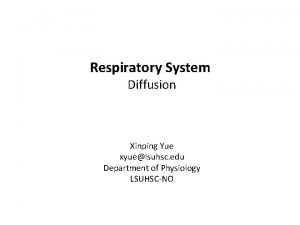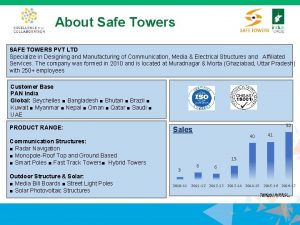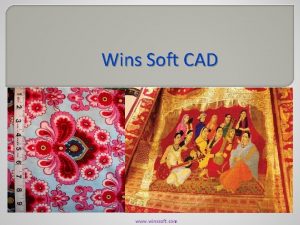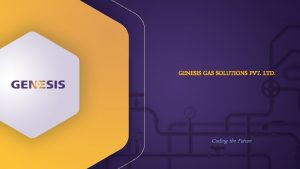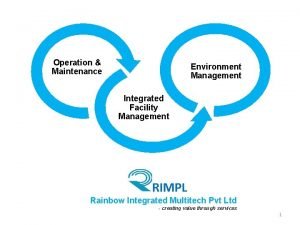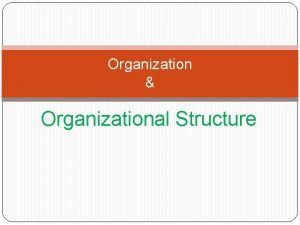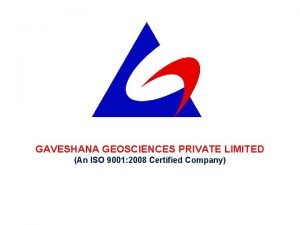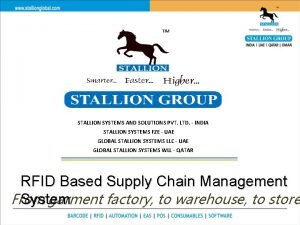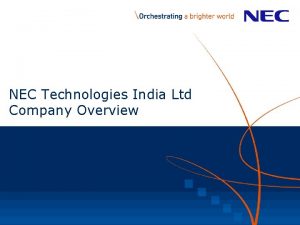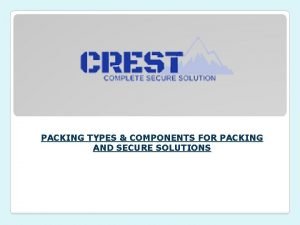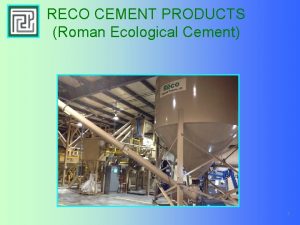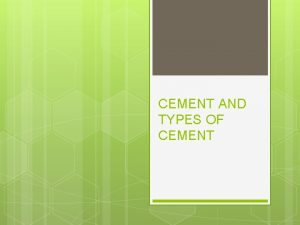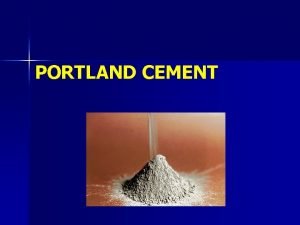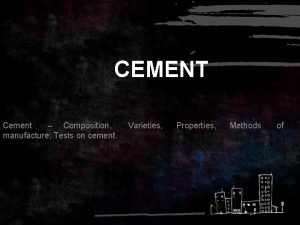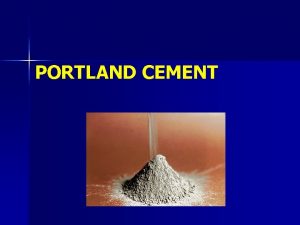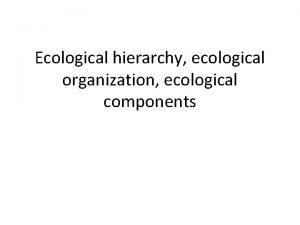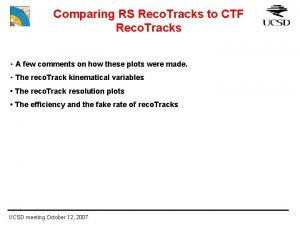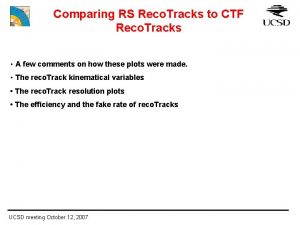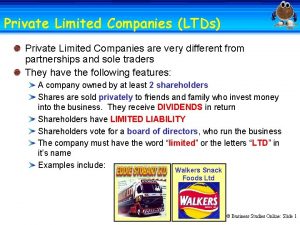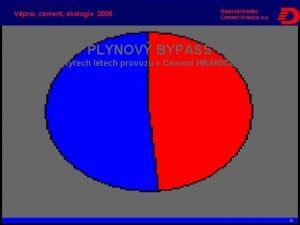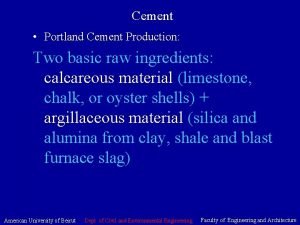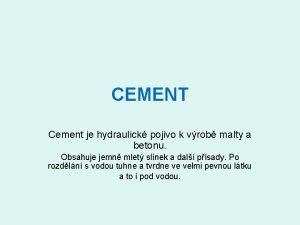Roman Ecological Cement Products Private Limited RECO Roman
































- Slides: 32

Roman Ecological Cement Products Private Limited (RECO)

Roman Ecological Cement Products Pvt. Ltd.

Early History of Roman Cement Research Ø FACT : 2000 year old Roman Cement used Volcanic Ash ( Class N) Ø RECO Started with varieties of Ash - Class C and Class F fly ash Ø RECO Examined the broad history of ash experiments Ø Tested mixture with a wide variety of global ashes, including Class C and Class F to achieve acceptable concrete strengths Ø Patented the ability to match the ingredients to the Ash in U. S. A, India and world wide Ø The history of fly ash research by RECO began as testing the properties of Portland Cements blended with sources of fly ash

What is Roman Ecological Cement RECO Ø Roman Ecological Cement is a mineral admixture for normal Portland Cement, HVFA (High Volume Fly Ash) cement and concrete mixture Ø Primary Ingredients – Fly ash (Class C, Class F, Pond Ash or Fly Ashes which do not meet C 618 Standard Specification) Ø Secondary Ingredients – Reactive Pozzolanic material – Proprietary Binder Ø It is formulated to enhance strength, durability, impermeability and workability of fresh concrete.

OBJECTIVES Ø Provides a High Performance Cement Superior to Ordinary Portland Cement (OPC ) Ø Produce Cement at a Lower Cost than OPC Ø Greatly reduces Air pollution (Carbon Emissions) associated with OPC Ø Reduces Permeability - The Main Cause of concrete decomposition and failure

Fulfilling Our Objectives Ø Utilize Fly Ash not presently usable SCM Ø Utilize in-spec and off-spec ash Ø Utilization of Ash meeting C 618, which is not accepted by the cement industry Ø Utilize low cost Ash reclaimed from ponds Accomplishments Ø Reduced total cementitious materials requirement - Leaner mix ->10 - 30% cost savings Ø Reduced Water/ Cement ratio by 10 - 20% Ø Reduced energy needs and CO 2 Emissions

Reduce Energy Needs and CO 2

Low Permeability Ø ASTM C 672 - Scaling Resistance(average of three specimen) Ø ASTM C 672 - Rapid Chloride Permeability ( average of three specimen)

Technology Combine OPC, Fly Ash and RECO Cement additive(RCA) as partial cement replacement. Fly/ Pond Ash 30 – 50% RECO Binder 15 – 20% Up to 70% OPC Replacement OPC 25 – 50%

Under the Microscope “…a unique Combination of Hydration and Pozzolanic Reactions are the main mechanisms of hardening and strength gain within Reco Cement based products” Typical microstructure of concrete made using RECO Additives

100% OPC vs. 50% replacement of OPC with Roman Cement Additive

Higher Compressive Strengths ASTM C 39 – Compressive strength(Average of three 4”x 8” cylinders) ASTM C 666 – Freeze- Thaw Resistance(Average of three specimen)

High Volume Fly-Ash 65% Replacement of OPC

100% OPC vs 65% Replacement

Class F High LOI(3%) India

100% OPC vs 50% OPC, 50% India Class F High LOI(3%) Fly Ash, and RECO

100% OPC vs 30% OPC, 70% India Class F High LOI Fly Ash, and RECO

Recent Testing

One Year Old Testing

73% Replacement of OPC Using Fly-Ash

High Strength achieved in precast using High LOI (3%) Fly-Ash(Barbados) 50% Replacement of OPC

Class F High LOI (10%) (Hawaii)

RECO TESTING We are constantly testing and improving our products

How does Blended Cement with RECO Cement affect Concrete Properties ? Ø Ø Ø Fresh concrete effects are all favorable Lower water demand, slump loss Excellent finishing properties Setting: Generally No Change for straight cement systems Similar response to admixtures - accepts traditional admixtures Strength development: at least equivalent Rate of strength gain and ultimate strength have shown to increase by minimum 15 -20% over time Reduced thermal cracking Heat of hydration and durability attributes are significantly improved Meets ASTM C 595 Specification (hydration, shrinkage, expansion) Meets General Purpose Cement Specs

How to Implement Roman Cement in a Ready Mix Facility Incorporate RECO Binder by utilizing exiting Silo for Fly-Ash

Manufacture a Superior Cement Product with a Strong Profit Margin with Minimal Plant set-up costs FA OPC MIXER RECO Binder FINISHED PRODUCT

How to implement RECO Binder, in to existing cement manufacturer Reco Cement Binder is added at ball mill stage

How is it made, and what’s different about it ? Ø A metered proportion of crushed, dried limestone and Glass is fed to the grinding mill along with clinker, gypsum, fly-ash and/ or slag Ø The RECO Cement Additive is more easily ground than the clinker(which is harder) and becomes concentrated in the finest particles Ø Overall fineness must be higher(for equivalent performance) in order for fineness of clinker fraction to be similar to OPC - Production rate is slowed - Some additional grinding energy is required but is more than offset by lower clinker content and related kiln savings Ø Particle size distribution is enhanced Ø Hydration is enhanced by both physical and chemical interaction greater overall Cementitious efficiency is possible Ø Sustainability benefits are significant via reduced associated carbon emission and embodied energy(less clinker)

Summary What’s different about RECO Cement? Ø Higher Strength Ø Improved Workability Ø Longer Durability Ø Reduced water requirement Ø Lower life cycle Cost Ø Lower Heat of Hydration and Ø Uses Recycled or local materials in the mix thermal cracking during setting Ø Low Permeability

RECO Research Center

RECO Current Customers Holcim(USA) La. Farge(USA) TCL(Caribbean) Finja(Sweden) We. Energies (We. Energies is the largest power company in Wisconsin and is funding another plant for RECOCement in Wisconsin to utilize their fly ash) Ozinga (Chicago lllinois) Green Building Products Preconco (Bardados) Precasting Omya (USA) Ram. Rock (USA) Quikrete (USA) (Large US Manufacturer of Bagged and Specialty Cements)

Thank You for your undivided attention Navrattan – RECO – India For More Company Information Click Below http: //www. romancementindia. com http: //www. recocement. com
 Reco reco portugal
Reco reco portugal Reco cement
Reco cement Genie auto products private limited
Genie auto products private limited Oracle mman
Oracle mman Reco condusef
Reco condusef Ficks law
Ficks law Garuda aerospace private limited
Garuda aerospace private limited Safe towers pvt. ltd photos
Safe towers pvt. ltd photos Wins soft innovations private limited
Wins soft innovations private limited Alexis global
Alexis global Www.rakshatpa.com
Www.rakshatpa.com Genesis gas solutions private limited
Genesis gas solutions private limited Savex technologies
Savex technologies Vayudoot logistics
Vayudoot logistics Sag infotech private limited
Sag infotech private limited Tara tradelink private limited
Tara tradelink private limited Private limited company advantages and disadvantages gcse
Private limited company advantages and disadvantages gcse Sanvo resorts private limited
Sanvo resorts private limited Rainbow integrated multitech private limited
Rainbow integrated multitech private limited Nursing organizational chart in hospital
Nursing organizational chart in hospital Avgol india private limited
Avgol india private limited Alfresco
Alfresco Vadera tradelink private limited jodhpur
Vadera tradelink private limited jodhpur Gaveshana geosciences private limited
Gaveshana geosciences private limited Stallion systems
Stallion systems Nec hcl system technologies limited
Nec hcl system technologies limited Stiriti ayur therapies private limited
Stiriti ayur therapies private limited Lokmanya hospitals private limited
Lokmanya hospitals private limited Sag infotech private limited
Sag infotech private limited Skid lashing services
Skid lashing services Swan hyderabad
Swan hyderabad Espouse technology private limited
Espouse technology private limited Disa decorations private limited
Disa decorations private limited





